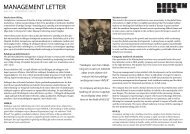Note 1 - Beerenberg
Note 1 - Beerenberg
Note 1 - Beerenberg
Create successful ePaper yourself
Turn your PDF publications into a flip-book with our unique Google optimized e-Paper software.
<strong>Note</strong> 3 | Accounting principles<br />
Intangible assets are amortised on a straight-line basis over<br />
their estimated useful life from the time they are available<br />
for use, since this most closely reflects the consumption of<br />
the future economic benefits embodied in the asset. The estimated<br />
useful lives for the current period and comparative<br />
periods are as follows:<br />
▪▪<br />
Customer relationships 10 years<br />
▪▪<br />
Technology 10 years<br />
Amortisation method, useful life and residual value are<br />
reviewed annually and adjusted if necessary.<br />
Impairment losses<br />
When the carrying amount of a non-current asset is higher<br />
than the estimated recoverable amount, the value is written<br />
down to the recoverable amount. The recoverable amount is<br />
the greatest of fair value less cost to sell and its value in use.<br />
The scope for reversing any previous write-downs (except<br />
goodwill) is assessed on each reporting date.<br />
With the exception of inventories (see Inventories) and<br />
deferred tax assets (see Income tax), the carrying amount of<br />
the Group’s fixed assets is continually assessed to determine<br />
whether there is any indication of impairment. If any such<br />
indication exists, the asset’s recoverable amount is estimated<br />
(see Calculating the recoverable amount).<br />
Goodwill and intangible assets with indefinite useful lives<br />
are tested for impairment annually.<br />
An impairment loss is recognised when the carrying amount<br />
of an asset or cash-generating unit exceeds the recoverable<br />
amount. Impairment losses are recognised through profit or<br />
loss.<br />
Impairments estimated for cash-generating units are allocated<br />
so that the carrying amount of any goodwill in the<br />
cash-generating units is reduced first. Next, the remaining<br />
impairment losses on the other assets in the unit are allocated<br />
pro rata based on the carrying amount.<br />
If an impairment in the fair value of a financial asset available<br />
for sale has been taken directly to other income and<br />
expenses, and if there is objective evidence that the asset has<br />
been the subject of an impairment, the accumulated loss that<br />
has been recognised directly in other income and expenses<br />
in profit or loss will be recognised. This applies even if the<br />
financial asset has not been realised. The loss recognised in<br />
profit or loss is the difference between the acquisition cost<br />
at the time of acquisition and the current fair value, less any<br />
impairment of the financial asset previously recognised in<br />
profit or loss.<br />
Calculating the recoverable amount<br />
The recoverable amount of an asset is the greater of the net<br />
selling price (less cost to sell) and value in use. The value in use<br />
is estimated by discounting expected future cash flows to their<br />
present value using a market-based risk-adjusted discount rate.<br />
For assets that do not generally generate independent cash<br />
flows, the recoverable amount is determined for the smallest<br />
cash-generating unit to which the asset belongs.<br />
Reversing impairment losses<br />
Impairment losses on goodwill are not reversed. In respect<br />
of other assets, impairment losses are reversed if there is any<br />
change to the estimates used to calculate the recoverable<br />
amount.<br />
Lease agreements (as a lessee)<br />
Leases under which the Group assumes substantially all<br />
the risks and rewards of ownership are classed as financial<br />
leases. Upon initial recognition the asset is measured at an<br />
amount equal to the lower of its fair value and the present<br />
value of the minimum lease payments. Subsequent to initial<br />
recognition, the asset is subject to the same accounting principle<br />
as equivalent assets.<br />
Other leases are operating leases and are not recognised in<br />
the Group’s statement of financial position.<br />
Inventories<br />
Inventories are measured at an amount equal to the lower of<br />
acquisition cost and net realisable value. The net realisable<br />
value is the estimated selling price in the ordinary course<br />
of business less the estimated cost of completion and selling<br />
expenses. The acquisition cost of manufactured inventories<br />
includes the direct cost of materials, direct labour and a<br />
share of indirect production overheads, while the acquisition<br />
cost of purchased inventories is the cost price based on the<br />
first-in-first-out principle and includes the cost incurred in<br />
acquiring the inventories, production or conversion overheads<br />
and other costs incurred in bringing them to their existing<br />
location and condition. In accordance with IAS 2.28,<br />
the value of inventories is written down to the net realisable<br />
value if the inventories have been damaged or have become<br />
wholly or partially obsolete or if the selling price has fallen.<br />
Cost of sales for the year comprises the cost price of goods<br />
sold plus any write-down in accordance with IAS 2.28 at the<br />
end of the year.<br />
Pension costs and pension obligations<br />
Pension costs and pension obligations are treated in accordance<br />
with IAS 19. Pensions are described in <strong>Note</strong> 20. The net<br />
38<br />
<strong>Beerenberg</strong> CORP. AS Group group accounts 2012












